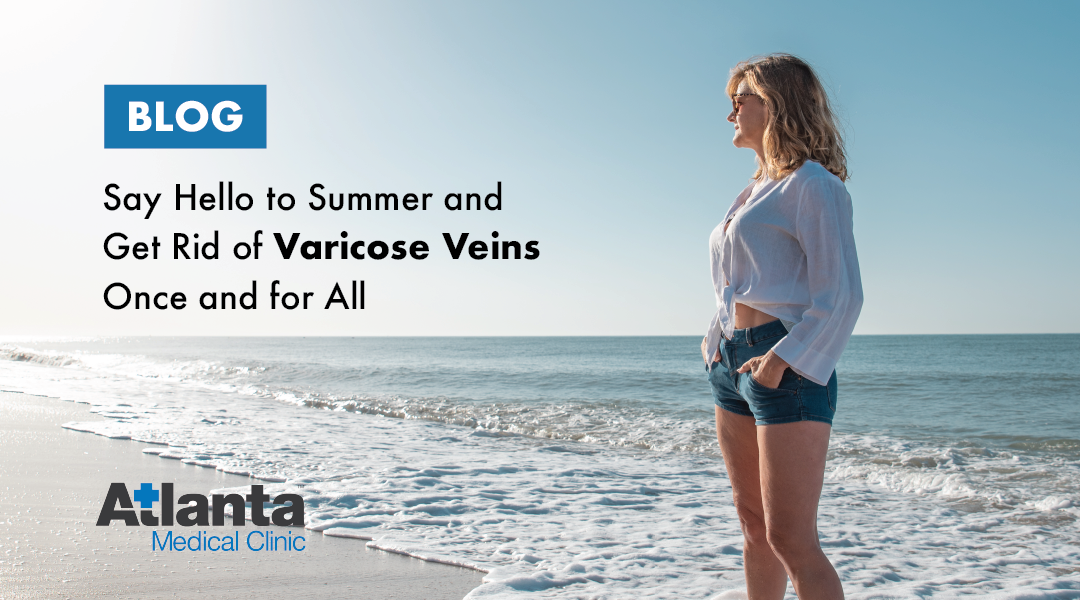Summer is in full swing – and with warmer temperatures and longer days, many of us are taking the opportunity to relax in the fresh air. Whether it be weekend trips to the beach, days spent poolside, or more walks with your beloved pet, there’s never been a better time to get outside! However, living with varicose veins can put a real damper on summer plans. Cosmetically, they can affect appearance and self-confidence while also causing severe pain and discomfort. So, if you’ve been hiding behind your varicose veins, it’s time to put an end to it once and for all.
What are Varicose Veins?
Varicose veins are enlarged, damaged, swollen veins that often twist and can be seen above the skin’s surface. They may be blue, red, or flesh-colored.
Varicose veins can appear anywhere on the body but are more common on the legs, such as the back of the calf or inside. Varicose veins most commonly affect the veins in the legs because standing and walking increase the likelihood of weak or damaged valves due to excess pressure placed on them.
How do Varicose Veins Occur?
Varicose veins result from poor circulation and excess pressure on damaged or weakened valves. In healthy veins, these valves push blood in one direction – toward our heart. However, when these valves weaken, blood flows backward and accumulates in the vein. The extra blood in the vein puts pressure on the walls of the vein and with continual pressure, the walls weaken and bulge, leading to varicose veins that rise to the surface. While varicose veins can affect anyone, some may risk developing them more than others. For example, those who sit or stand for long periods and those who are pregnant are more susceptible.
Symptoms of Varicose Veins:
While the first thing one may notice about varicose veins is their appearance, it’s essential to note that they are more than a cosmetic problem. If left untreated, varicose veins can lead to an array of health conditions, including:
- Painful swelling and tenderness
- Burning sensation
- Severe muscle cramps
- Tired and achy legs
- Bleeding
- Skin discoloration
- Blood clots
How to Treat Varicose Veins
Preventative care: If you are at high risk of developing varicose veins, take preventive measures to encourage healthy blood flow and circulation, such as:
- Regular exercise to strengthen the surrounding muscle.
- Elevation to reduce swelling and inflammation.
- Compression therapy to increase blood flow.
Non-Surgical Procedures: For existing varicose veins, multiple non-surgical treatments are available to provide instant, long-lasting relief, including:
- Radiofrequency Ablation (RFA): Radiofrequency ablation is a minimally invasive treatment that uses radiofrequency energy to heat up and damage the wall inside a vein. Once closed, blood will naturally take an alternate path toward healthy veins, leading to regular blood flow and returning blood from your legs to your heart for long-lasting relief.
- ClariVein OC: One of the newest endovenous ablation technologies, ClariVein OC uses a special catheter with a rotating tip to cover all 360 degrees of the vein and deliver medication to close the varicose vein, resulting in increased blood flow, reduced discomfort, and cosmetic improvement.
- Sclerotherapy: This noninvasive treatment involves an injection of a saline solution directly into the vein. The solution irritates the lining of the blood vessel, causing it to collapse and disappear.
Experience Immediate Relief with Atlanta Medical Clinic
The team at Atlanta Medical Clinic offers patients the most advanced and effective non-surgical technologies so you can enjoy those summer months without hiding behind your veins. In addition, all procedures are minimally invasive, allowing you to return to regular activities the same day. Contact us to learn more about how we can help you experience immediate, long-lasting relief.

